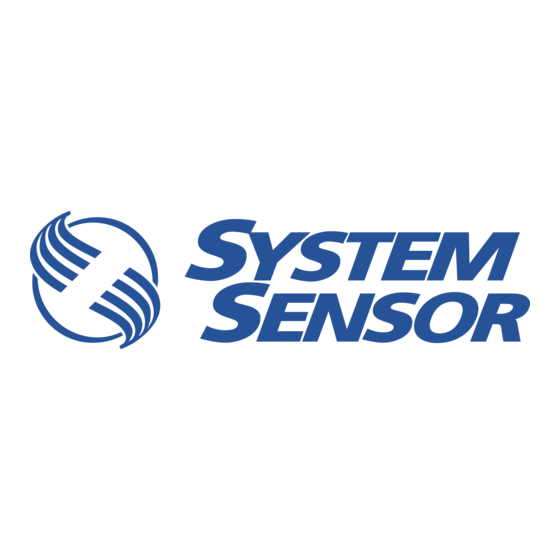Advertisement
Quick Links
ACCESS MENUS
INSTALLATION AND MAINTENANCE INSTRUCTIONS
2251EIS Intrinsically-Safe Plug-in
Intelligent Photoelectronic Smoke Detector
Specifications
Operating Voltage Range:
Standby Current:
Max. Alarm Current (LED on):
Operating Humidity Range:
Operating Temperature Range:
Europe–
U.S.–
Compatible Bases:
Before Installing
This sensor must be installed in compliance with the con-
trol panel system installation manual. The installation must
meet the requirements of the Authority Having Jurisdiction
(AHJ). Sensors offer maximum performance when installed
in compliance with the National Fire Protection Association
(NFPA); see NFPA 72.
NOTICE: This manual should be left with the owner/user
of this equipment.
IMPORTANT: This sensor should be cleaned at least once a
year. If cleaning is performed with non-intrinsically safe
equipment, it must be conducted outside the hazardous
area.
General Description
Model 2251EIS is an intrinsically-safe, plug-in type smoke
sensor that combines a photoelectronic sensing chamber
with addressable-analog communications. The sensor trans-
mits an analog representation of smoke density over a regu-
lated communication line, through a barrier, to an intelligent
system translator (sold separately, IST200). The translator
then relays the analog information to a control panel.
Rotary-decade switches are provided for setting the sensor's
address. Two LEDs on the sensor are controlled by the panel
to indicate sensor status.
Wiring Instructions
All wiring must be installed in compliance with all appli-
cable national codes of practice and regulations (e.g. in the
UK, EN60079-14; 1997). The installation wires should be
shielded and properly grounded.
D200-70-00
17 to 24 VDC
330µA @ 24 VDC (one communication every 5 sec. with LED blink enabled)
2.5 mA @ 24 VDC
10% to 93% Relative Humidity, Noncondensing
–10° to 60°C
32° to 120°F (0° to 49°C)
B501
NOTE: The maximum length of wire that can be connect-
The system must be marked with a system label that is
packed with the 2251EIS. This label must be placed on or
adjacent to the principal item of electrical apparatus in the
system, or at the interface between the intrinsically safe
and non-intrinsically safe circuits.
Remove power from the communication line before
installing sensors.
All wiring must conform to applicable local codes, ordi-
nances, and regulations.
1. Wire the sensor base (supplied separately) per the
2. Set the desired address on the sensor address switches,
3. Install the sensor into the sensor base. Push the sensor
4. After all sensors have been installed, apply power to the
5. Test the sensor(s) as described in the TESTING section
Figure 1. Rotary decade address switches:
1
3825 Ohio Avenue, St. Charles, Illinois 60174
ed to the detector side of the barrier is limited by
the barrier resistance, the wiring capacitance, and
the characteristics of the control panel. For more
detailed information, refer to the literature sup-
plied with the control panel.
wiring diagram.
see Figure 1.
into the base while turning it clockwise to secure it in
place.
control unit and activate the communication line.
of this manual.
4 5
3
6
2
7
8
1
0
9
A Division of Pittway
1-800-SENSOR2, FAX: 630-377-6495
4 5
3
6
2
7
8
1
0
9
A78-2460-00
I56-1181-03R
Advertisement

Summary of Contents for System Sensor 2251EIS
- Page 1 (NFPA); see NFPA 72. The system must be marked with a system label that is packed with the 2251EIS. This label must be placed on or NOTICE: This manual should be left with the owner/user adjacent to the principal item of electrical apparatus in the of this equipment.
-
Page 2: Access Menus
ACCESS MENUS Figure 2. Test magnet position: CAUTION Dust covers provide limited protection against airborne dust particles during shipping and must be removed before the sensors can sense smoke. Remove sensors prior to heavy remodeling or construction. Be sure to remove the dust covers from any sensors left in place during construc- tion prior to returning the system to service Testing... -
Page 3: Hazardous Area
IST200 Intelligent Diode Safety System Translator Barrier (see Note 1) B501 Base To next Model 2251EIS Smoke Detector devices EEx ia IIC T5 BASEEFA No.: Ex 98D2020 All wiring shown is supervised and power limited. Group Capacitance Inductance L/R Ratio µF... - Page 4 Please include a note describing the malfunction and suspected cause of period of three years from date of manufacture. System Sensor makes no failure. The Company shall not be obligated to repair or replace units other express warranty for this smoke detector.
-
Page 5: Installation And Maintenance Instructions
INSTALLATION AND MAINTENANCE INSTRUCTIONS A Division of Pittway IST200 Intelligent System Translator 3825 Ohio Avenue, St. Charles, Illinois 60174 For Use With Intrinsically Safe Detectors 1-800-SENSOR2, FAX: 630-377-6495 Specifications Input Voltage (V in): 15 to 32 VDC Output Voltage: 20 to 24 VDC Input Current: 17mA @ V in = 15V 9.7mA @ V in = 24V... - Page 6 2. It is recommended that all installation wires be shielded and properly grounded. Three-Year Limited Warranty System Sensor warrants its enclosed translator to be free from defects in ment, RA #__________, 3825 Ohio Avenue, St. Charles, IL 60174. Please materials and workmanship under normal use and service for a period of include a note describing the malfunction and suspected cause of failure.






Need help?
Do you have a question about the 2251EIS and is the answer not in the manual?
Questions and answers